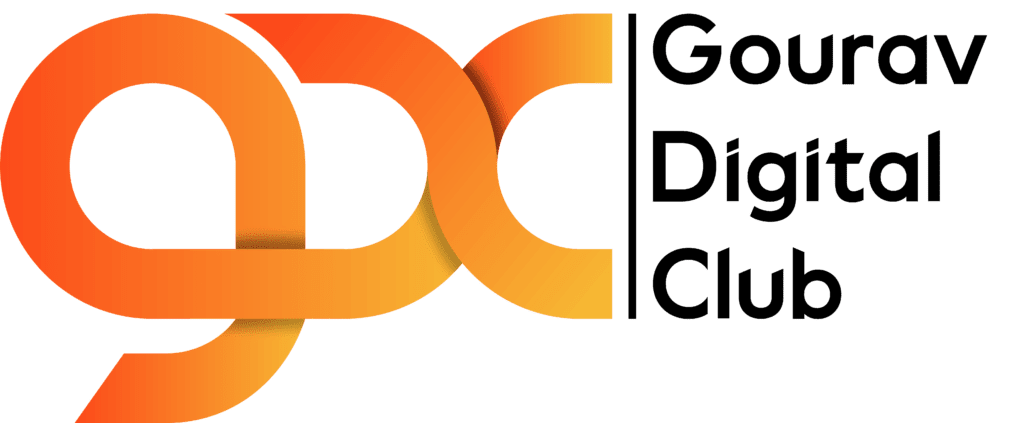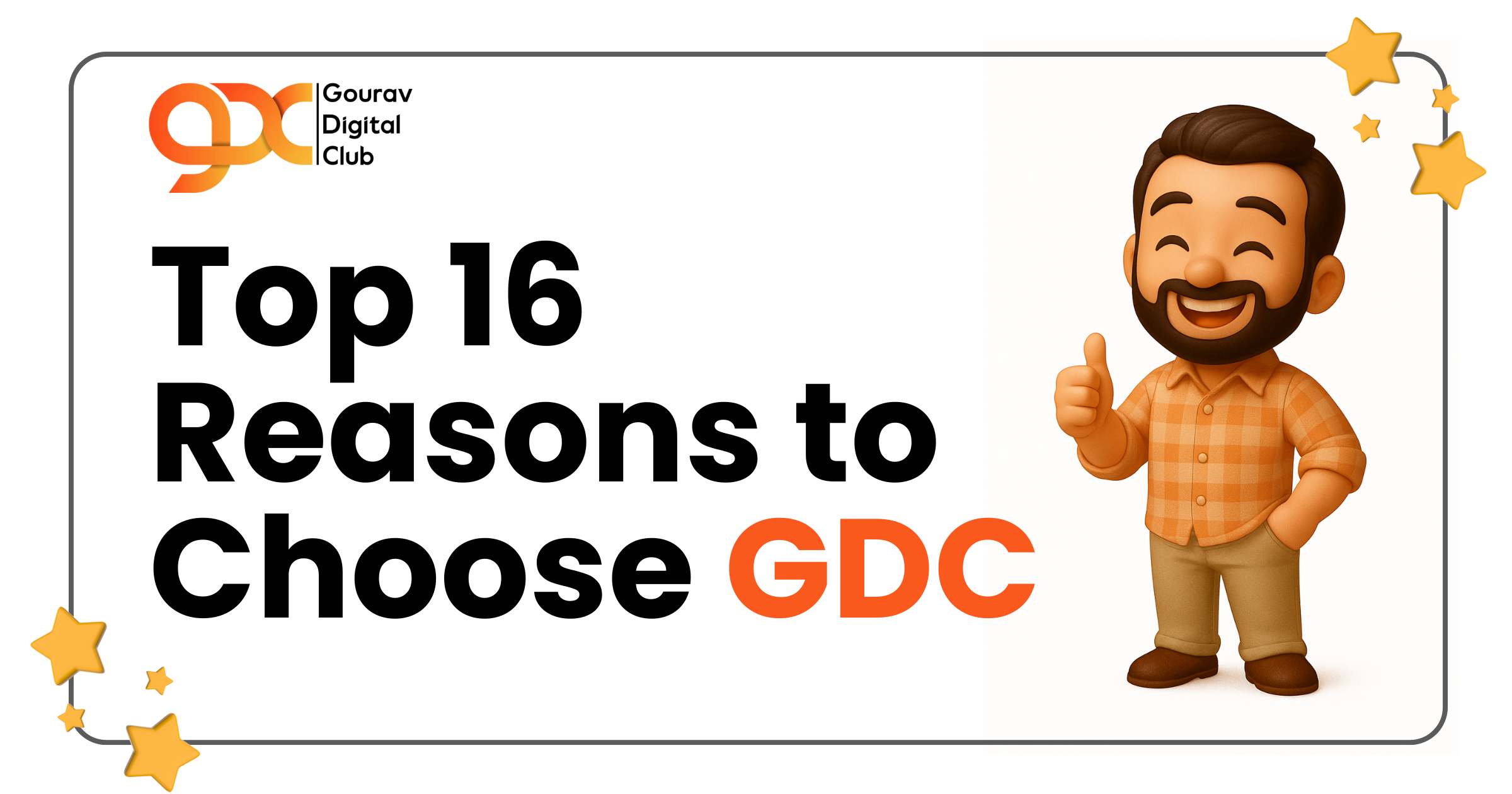Table of Contents
ToggleWhen you hear the word portfolio, you probably think of artists, photographers, or graphic designers. But guess what? If you’re getting into marketing—even as a student—a portfolio can be just as important for you.
A digital marketing portfolio is basically a collection of your work that shows what you’re capable of. It’s more than just telling someone you can write good copy or run an ad campaign—it’s showing them. Think of it like your personal highlight reel.
Instead of listing skills on a CV (like “social media strategy” or “SEO”), your portfolio lets you bring those skills to life. You can include things like:
- A social post you designed that got great engagement
- A blog post you wrote for a class project
- A report showing how you analyzed campaign data
- Even your own side projects, like growing a personal brand or running a YouTube channel
And don’t worry—you don’t need years of professional experience to start. Projects from school, internships, or even your own experiments all count. What matters most is how you show your thinking and what kind of results you achieved.
In a nutshell:
-Your CV tells people what you say you can do.
-Your portfolio shows them what you’ve actually done.
Up next, let’s break down the key differences between the two—and when to use which.
The Key Differences Between a CV and a Portfolio
So, what’s the difference between a CV and a digital marketing portfolio—and when should you use each?
Let’s start with the basics:
A CV (or résumé) is more like a snapshot. It lists your education, skills, certifications, and past roles. It’s usually one or two pages long and gives recruiters a quick overview of who you are on paper.
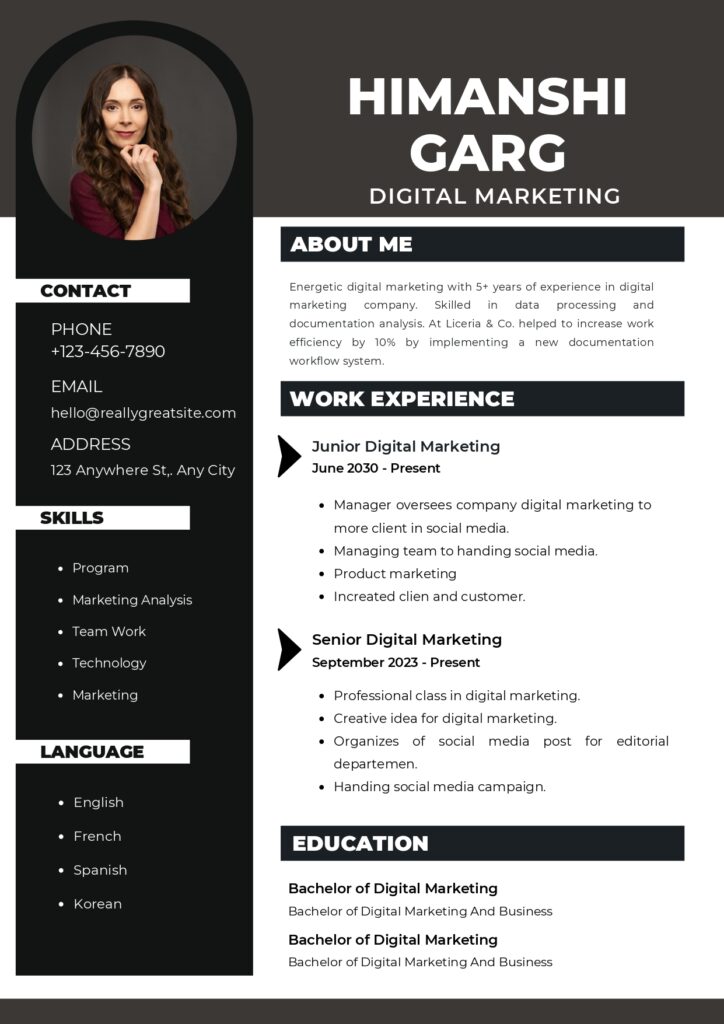
Image credit: canva.com
A portfolio, on the other hand, is the full story. It shows your actual work in action—projects, campaigns, writing samples, reports, visuals, and more. It’s where you prove you can walk the talk.
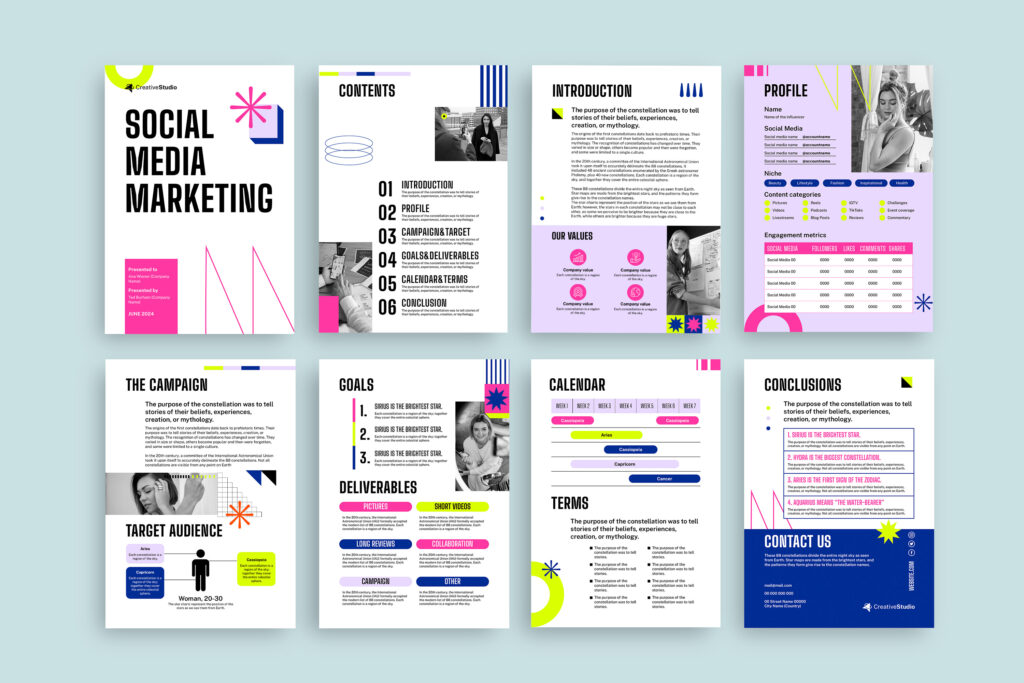
Image credit: freepik.com
Here’s a quick side-by-side to make it clearer:
| Aspect | CV | Portfolio |
|---|---|---|
| What it is | A structured summary of your background, qualifications, and skills | A collection of actual work showcasing your experience and impact |
| Main Purpose | To provide a quick overview of your career and skills | To demonstrate your ability through real examples and results |
| Format | Text-based document (Word, PDF) | Visual, interactive, often web-based or in a presentation format |
| What it Includes | Education, work history, job roles, certifications, soft/hard skills | Projects, case studies, metrics, visuals, tools used |
| Style/Tone | Formal, professional, concise | Creative, flexible, can match your personality or brand |
| Best Used For | Job applications, corporate/academic roles | Freelance gigs, marketing, design, and creative roles |
| Update Frequency | Occasionally – usually before a job application | Frequently – every time you finish a new project |
| Standout Factor | Clarity, structure, and presentation of your achievements | Real-world results, creativity, and storytelling |
| Platform | Usually offline (PDF/print/email attachment) | Often hosted online – on portfolio websites, LinkedIn, Behance, etc. |
| Important Point | Great for getting your foot in the door | Essential for standing out in creative, freelance, and marketing industries |
So which one do you need?
The answer is usually: both.
Use your CV to get through the door (especially when applying through job portals or company websites), and use your portfolio to wow them once they’re interested.
Here’s how to decide when to use each:
Use your CV when:
- You’re applying through job boards or company portals
- The recruiter asks for a formal application
- You want to highlight your education, certifications, or transferable skills
- You’re applying to roles that are less creative and more analytical
Use your portfolio when:
- You’re interviewing for creative or marketing-focused roles
- You want to show examples of real work you’ve done
- You’re reaching out to clients for freelance or side projects
- You need to demonstrate how you solve problems or deliver results
Your CV opens the door—it gives people a quick summary of who you are.
But your portfolio makes the impact—it shows what you’re capable of and helps people visualize what it would be like to work with you.
let’s walk through exactly what you should include in your digital marketing portfolio to make it stand out.
What Should You Include in a Digital Marketing Portfolio?

If you’re building your digital marketing portfolio for the first time, the big question is: What should actually go in it? Whether you’re a student just starting out or someone with a few projects under your belt, the goal is the same—showcase your potential in a clear, confident, and results-focused way.
Here are the key elements that make a portfolio truly effective:
1. A Short, Personal Introduction
This is your chance to say hello!
Include a brief paragraph about who you are, what you specialize in (or are learning), and what you’re passionate about in marketing. Keep it friendly and professional.
Example: “Hi, I’m Aanya, a marketing student with a love for social media strategy, branding, and content creation. I enjoy turning ideas into engaging campaigns that connect with real people.”
2. Your Best Work
Choose 3 to 5 projects that show off your skills. These could be:
- University or class assignments (campaigns, presentations, reports)
- Internship work (with permission to share)
- Personal passion projects (like managing a blog, YouTube channel, or Instagram brand)
- Simulated or mock campaigns you’ve created for practice
Each project should include:
- A short description of what it was
- Your role and what tools or platforms you used
- The outcome or results (even if they’re hypothetical or based on feedback)
3. Skills in Action
Rather than listing your skills like you would on a CV, your portfolio should show them:
- If you’re good at writing, include content samples or blog posts
- If you’re into data, show charts or reports with insights
- If you enjoy design, show social posts, infographics, or email templates
This makes your skills feel real and valuable, not just words on a page.
4. Results or Reflections
You don’t always need hard numbers, especially as a student—but if you have them, use them!
- “This campaign increased engagement by 40% over two weeks”
- “After implementing my SEO suggestions, we moved up two spots on Google”
If you don’t have real results, talk about what you learned and what you’d do differently next time. This is what gives your digital marketing portfolio depth and personality.
5. Testimonials (Optional)
If a professor, classmate, or internship mentor gave you positive feedback, ask if you can quote them. Even a short, friendly sentence adds credibility.
6. Contact Information or Call to Action
Always include a way for someone to reach you:
- Email address
- LinkedIn profile
- Or even a “Let’s Connect” button if it’s on a website
Your portfolio doesn’t have to be perfect or packed with professional experience. What matters most is that it feels genuine, shows your potential, and makes someone say, “I’d like to work with this person.”
7. Certifications & Achievements
This section builds trust and shows that you’re serious about growing in your marketing journey—even if you’re just getting started.
You can include:
- Certificates from online courses
Google Digital Garage, Meta Blueprint, HubSpot Academy, Coursera, LinkedIn Learning - University or classroom recognitions
Top project presentations, campaign competitions, marketing club roles - Freelance or volunteer wins
Helping a local business grow its social media, running a small campaign for a student group, or leading a class initiative - Additional achievements
Awards, scholarships, leadership roles, or anything that adds to your personal brand
8. Case Studies
Adding case studies to your digital marketing portfolio is a great way to show your thinking, strategy, and results—not just the final product.
Even if you’re a student, you can build case studies from:
- Class projects
- Personal marketing experiments
- Freelance or volunteer work
What to include:
- Project Title & Goal
What was it about, and what were you trying to achieve? - Your Role
What part did you play? - Process
Tools, research, strategy—how you approached the task. - Results
Stats if available (e.g., +40% engagement) or what you learned. - Visuals
Add screenshots, charts, or social posts to make it real.
How to Set Up Your Digital Marketing Portfolio

Image credit: freepik.com
Creating a digital marketing portfolio may sound technical, but it’s really just about showcasing your work in a clear, accessible, and professional way. Whether you’re a student, freelancer, or beginner in the field, your first move should be to choose the right platform—something that aligns with your skill level and goals.
Step 1: Pick the Right Platform
You don’t need to be a designer or developer to build a great portfolio. Start with tools that are easy to use:
- No-code tools:
- AI-assisted builders:
- Durable.co – Uses AI to generate full websites in minutes
- Zyro or Bookmark – Quick templates, drag-and-drop, AI suggestions
- More advanced options:
- Wix or Squarespace – For more control over layout and visuals
- WordPress – Best if you want flexibility or blog features
Start with what feels comfortable—you can always evolve it as your skills grow.
Step 2: Structure It Logically
Once you pick a platform, organize your content into clear, useful sections. A basic structure looks like this:
- Home – Quick intro and what you offer
- About Me – Brief background, passions, and marketing interests
- Projects/Case Studies – Real or mock campaigns with short descriptions
- Certifications & Resume – Add links, badges, or downloadable files
- Contact – Email, LinkedIn, or a simple form
This structure helps the viewer find what they need fast—especially helpful if your digital marketing portfolio is being skimmed by a busy recruiter.
Step 3: Keep the Design Simple
You don’t need flashy effects or complex animations. The goal is clarity. Stick to a clean layout and let your content do the talking:
- Use just 2–3 colors that reflect your personal brand
- Choose one easy-to-read font and use it consistently
- Add screenshots, visuals, or mockups for each project
- Leave white space to give your work room to breathe
- Make sure it looks good on mobile as well as desktop
Step 4: Publish and Share
Once you’ve built your site, share it!
- Grab a custom domain (like yourname.com) if you can—it looks more professional
- Link it to your resume, LinkedIn, and email signature
- Keep it updated with new work, certifications, or skills
Pro Tip: Start simple. Even a clean Notion page with your name, key projects, and a short intro is a strong first version.
4 Real Digital Marketing Portfolio Examples You Can Learn From
Want to know what makes a great digital marketing portfolio? It’s not just about looking good—it’s about showing impact. These real-world examples showcase measurable outcomes that helped these marketers stand out.
1. Murad Murad – Bright, Bold, and Approachable
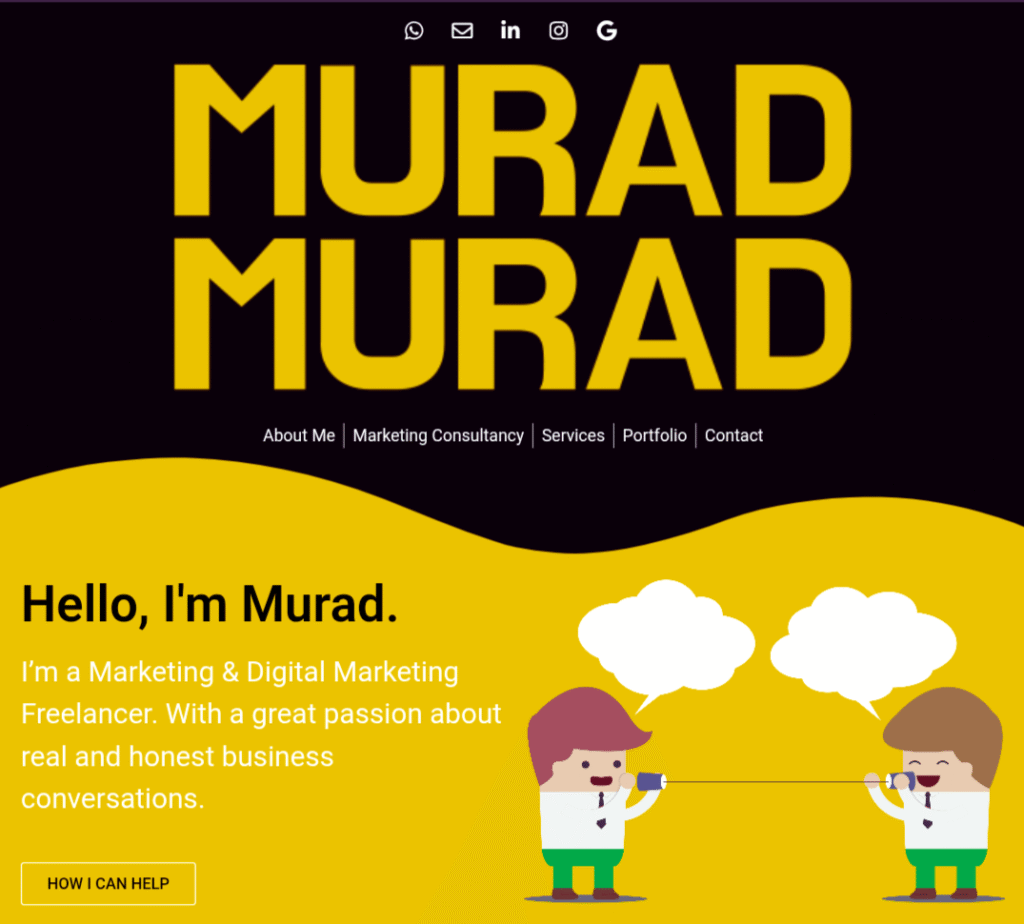

Murad Murad’s portfolio at muradmurad.com stands out with bold visuals, clear messaging, and a personality-first approach. It’s a great example of how a digital marketing portfolio can reflect both creativity and professionalism, especially when personal branding is central to your service.
What’s Great About This Portfolio?
- Bold visual identity: Uses strong colors and typography to make an immediate impression.
- Intro that connects: Opens with a friendly, confident headline that’s relatable and human.
- Focused content: Clear descriptions of services, with a strong emphasis on branding and strategy.
- Project snapshots: Brief, visually engaging case studies highlight his marketing skills and creative process.
- Smooth navigation: Each section flows logically, making it easy to explore.
- Personal branding: His digital marketing portfolio feels like an extension of his personality — creative, sharp, and approachable.
Takeaway:
A standout portfolio doesn’t just show your work — it shows who you are and how you think. Murad’s site proves you can be professional and bold.
2. Dayana Mayfield – Niching Down with Confidence
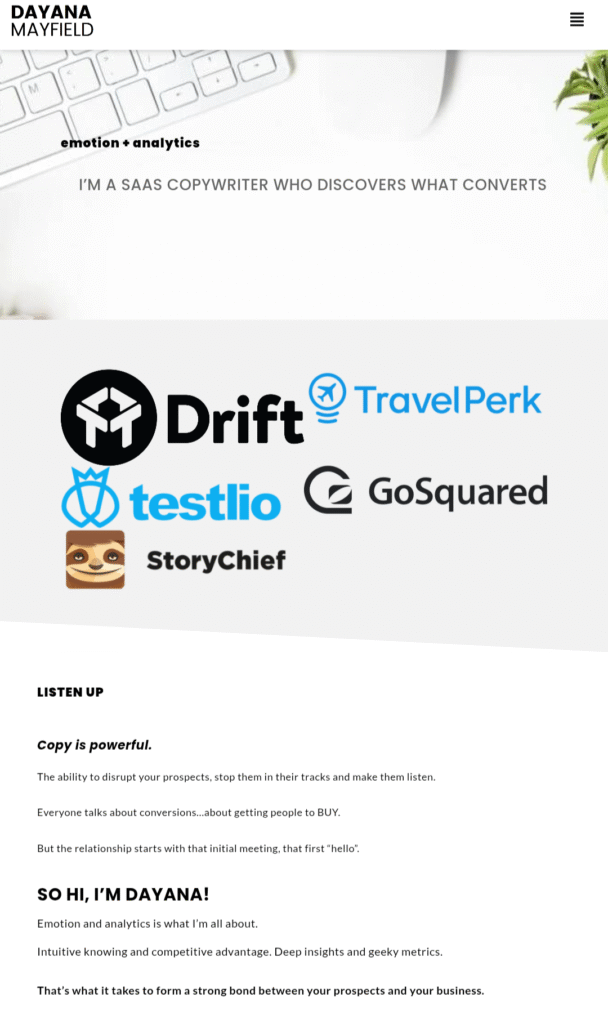
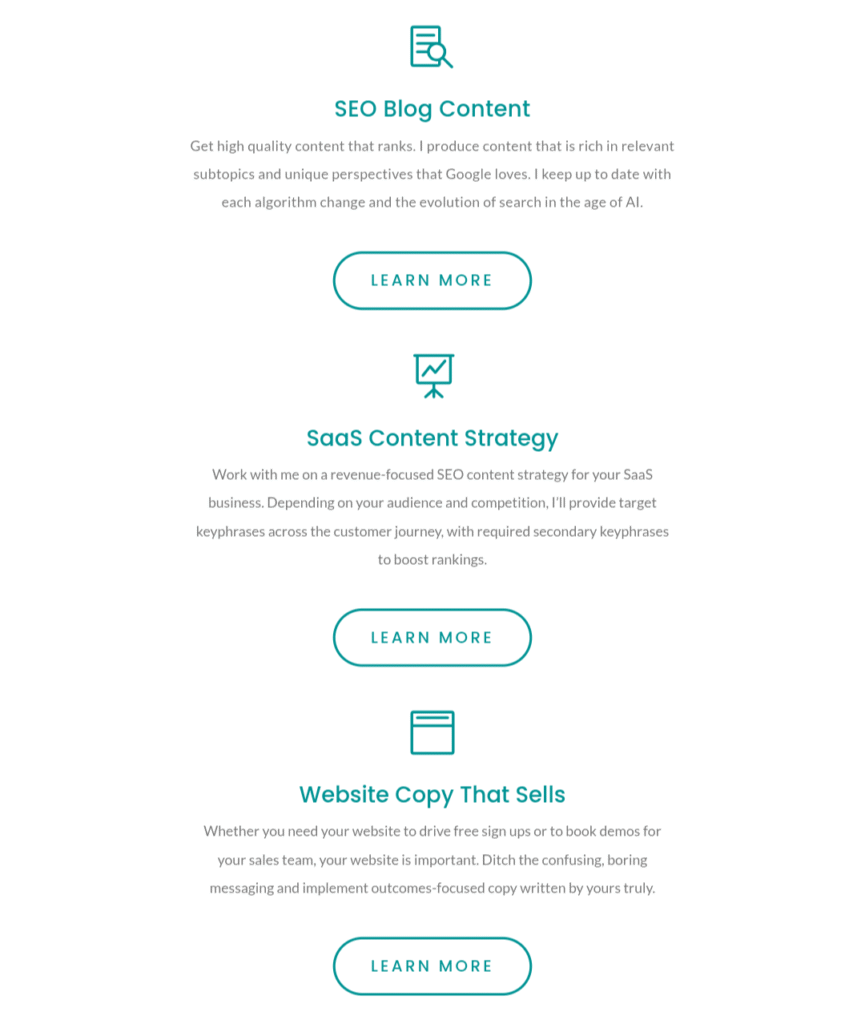
Dayana Mayfield’s portfolio at dayanamayfield.com is a masterclass in showing how clarity and specialization can elevate your digital marketing portfolio. She focuses tightly on B2B SaaS copywriting, and everything on her site is crafted to attract clients in that niche — from her copy to her case studies.
What’s Great About This Portfolio?
- Niche clarity: Focuses exclusively on B2B SaaS, making her digital marketing portfolio highly targeted and relevant.
- Powerful copy: Her homepage is copywriting in action — clear, persuasive, and benefit-driven.
- Client-focused: The layout speaks more about her clients’ needs than her own resume.
- Detailed case studies: Each one explains the problem, solution, and results, proving her ROI-driven approach.
- Professional but personable: A clean, minimal design mixed with friendly tone and personal branding.
- Lead generation optimized: Includes opt-ins and soft CTAs to attract leads while showcasing value.
Takeaway:
A focused digital marketing portfolio with strong messaging can attract the right clients, not just any clients.
3. Bailey Cargill – Social Powerhouse
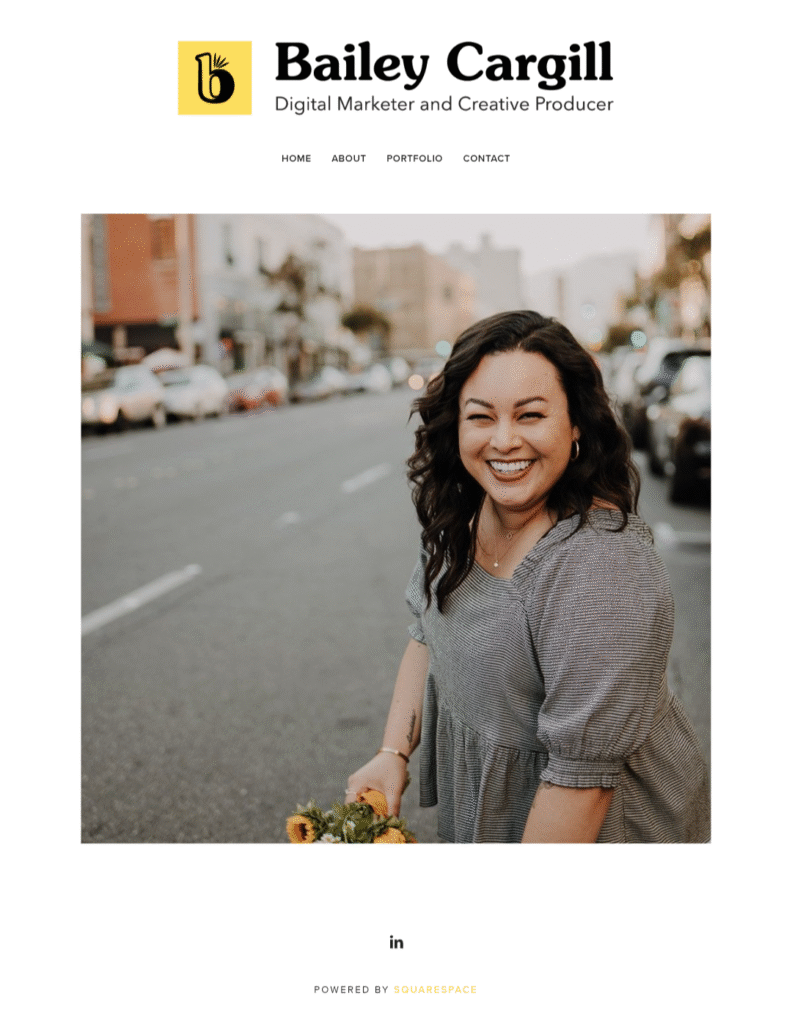
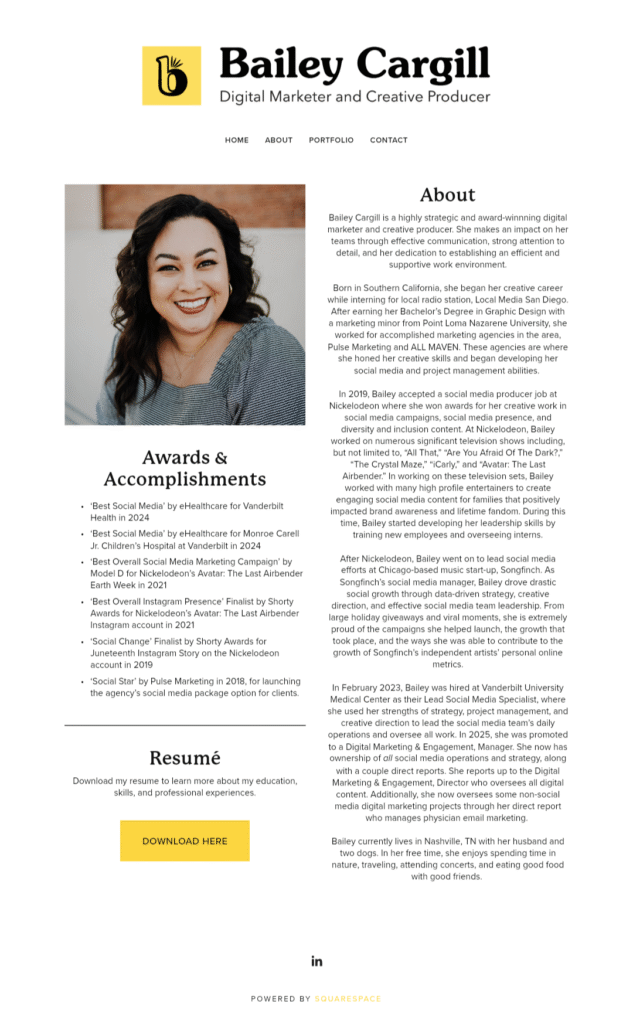
Bailey Cargill’s portfolio at baileycargill.com shows how strong personal branding and clear content can position you as a go-to expert in social media marketing. Her site is clean, confident, and full of personality — with a sharp focus on social strategy, content creation, and influencer collaboration.
What’s Great About This Portfolio?
- Bold, confident intro: Instantly tells visitors what she does and who she helps.
- Social media proof: Includes stats and brand collaborations (like Pretty Little Thing & HelloFresh).
- Visual storytelling: Lots of images and examples from Instagram, TikTok, and campaigns.
- Service clarity: Clear breakdown of services offered (UGC, strategy, creative direction).
- Personality-driven design: Fun, modern, and unmistakably her.
- Targeted appeal: Speaks directly to brands wanting strong, visual social presence.
Takeaway:
Bailey’s portfolio proves that in social media, your style is part of your value — and she delivers both.
4. Elizabeth Harmon – Mastering Testimonials & Trust

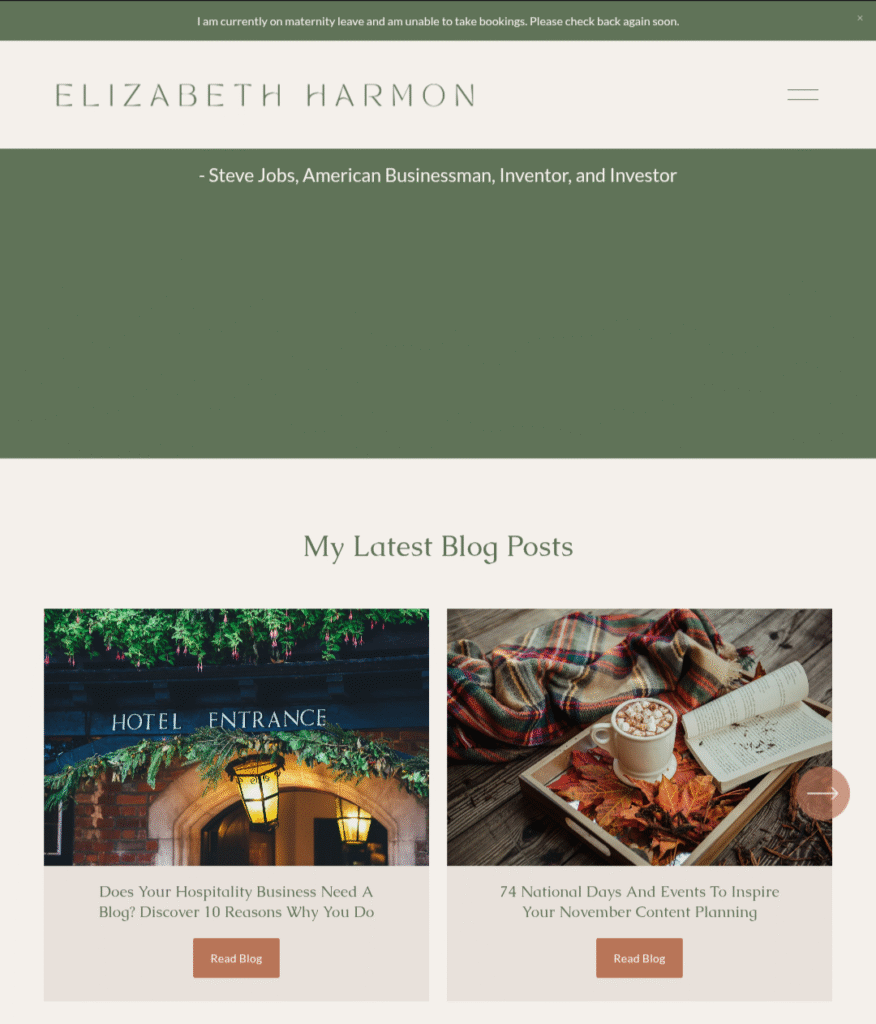
Elizabeth Harmon’s portfolio at elizabethharmon.co.uk is a great example of minimal design meets maximum impact. It’s designed to feel approachable but powerful, with a heavy emphasis on social proof, client trust, and clear results.
What’s Great About This Portfolio?
- Trust-first approach: Leads with testimonials and real results like 40–60% open rates.
- Proof over fluff: Every service is backed by data or case studies.
- Clean and focused layout: Simple design makes content easy to scan and understand.
- Strategic case studies: Each project highlights the goal, approach, and outcome.
- Friendly CTAs: Invites action without pressure (e.g., “Let’s chat”).
- Tailored niche: Speaks directly to her ideal clients in email and automation.
Takeaway:
Simple layout + real results + trust-building = powerful portfolio.
Conclusion
If you’ve made it this far—yay, go you!
Creating your digital marketing portfolio might feel like a big step, but it’s seriously one of the best ways to show off your marketing skills—especially if you’re just starting out.
You don’t need tons of experience to get going. Whether it’s student marketing projects, internship work, or personal experiments, every piece helps tell your story. Your beginner marketing portfolio is all about showing what you’ve learned, how you think, and what you’re excited to keep exploring.
Start simple. Pick a platform you like, choose a few projects you’re proud of, and let your personality shine through. You can always update and grow it as you build more experience.
So go ahead—start building your digital marketing portfolio today. Future-you (and potential clients or employers) will thank you for it.
